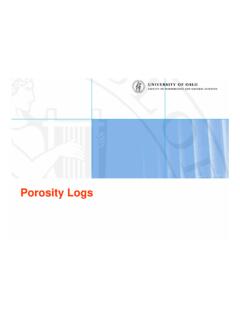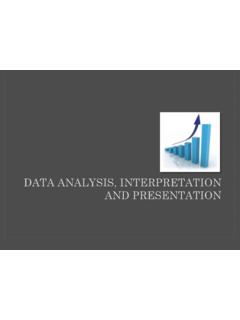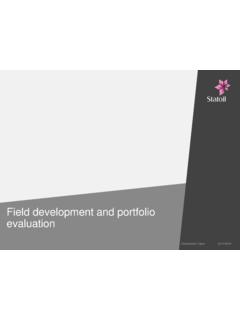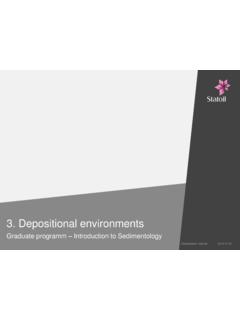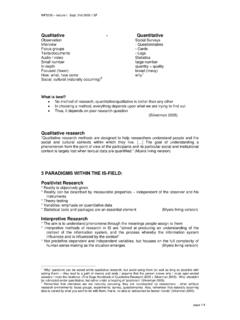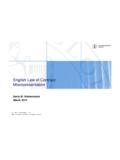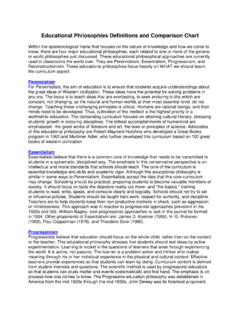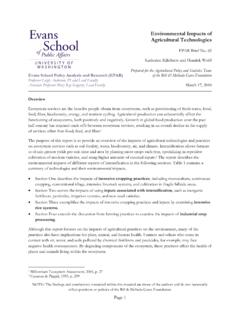Transcription of Theories of (Information) Technology in Organizations
1 Theories of ( information ) Technology in Organizations Sundeep Sahay Orikowski & Iacono (2001) The field of information systems is premised on the centrality of information Technology in everyday socio-economic life. Yet, drawing on a review of the full set of articles published in information Systems Research (ISR) over the past ten years, we argue that the field has not deeply engaged its core subject matter the information Technology (IT) artifact. Instead, we find that IS researchers tend to give central theoretical significance to the context (within which some usually unspecified Technology is seen to operate), the discrete processing capabilities of the artifact (as separable from its context or use), or the dependent variable (that which is posited to be affected or changed as Technology is developed, implemented, and used).
2 The IT artifact itself tends to disappear from view, be taken for granted, or is presumed to be unproblematic once it is built and installed. Issues of Debate/Problematization Nature of agency ascribed to Technology and to the social agent Conceptualizing Technology and its materiality itself (tool, artefact, ensemble) Analytical focus: human agent, teams/groups, organization , inter- organization , national and global contexts Focus on one shot versus process dynamics Theorizing context The level and nature of change Theoretical Relations Involved IT and change IT and learning IT and conflict/politics IT and knowledge IT and teams IT and globalization IT and complexity IT and risks/unintended effects IT and other technologies IT and health (or other domains)
3 Theoretical Trends From cognitivist, rational models From factors to process approaches From structure to practice based approaches Intermingling of the technical and social Understanding and accepting of indeterminacy More sophisticated understandings of context Breakdown of assumptions of structure (Identifiable, Quantifiable, Measurable, Predictable) Wider incorporation of other disciplines Towards situated, context-specific understandings - semi and unstructured problems What becomes important to theorize? Meanings Tacit understanding Experiences Interconnections (gestalt) Situations - work practices Process of change Unintended effects Within this context Informationn Technology theorizing starts to draw upon.
4 Anthropology social theory sociology of knowledge philosophy politics domain areas (development, democracy, public health) Let us take some examples Structuration theory Actor network theory information infrastructure theory Institutional theory Risk society Structuration Theory British Sociologist - Anthony Giddens Critique of too much focus on content Not enough focus on process, context, and linkage between context and process Focus either on human interactions Or on social structure Theory tries to resolve this dualism Signification Domination Legitima- tion Communication Power Sanction Interpretative scheme Norm Facility Structuration Theory Modalities Communication - interpretative schemes, stocks of knowledge.
5 Meanings (structures of signification) Power - facility, resources (material and human), (structures of domination) Sanction - norms, standards of morality, legitimate action (structures of legitimation) Structures Rules Resources Existing in memory traces Come to the fore in action (manifest in action) Human Agent Reflexive Capable Knowledge Monitoring of action Intentional conduct Revision and changes Unintended consequences Approaches to theorize Technology as structure (early orlikowski) Technology as modality Technology as enacted in practice Technology as occasion for structuring (barley) Framework for theorizing Technology Content - organization .
6 IS Social context - social relations, infrastructure, history Social processes culture - subcultures, multiple meanings politics - control/autonomy, morality communication etc Framework applied to system design and development Content - requirements specification, development focus Social context - senior management attitude, project team composition Social process - participation, training (communication, learning, negotiation) (Walsham- chapter 9) Actor Network Theory Aeroplanes dont fly Airlines Implications for theorizing Technology can only be understand as a part of a complex socio-technical hetrogeneous network What becomes important to understand: Who/what are the networks?
7 What brings them together (or not) What breaks down the network etc Concepts provided by ANT Actors/Actor networks Inscriptions Translations (4 moments: problematization, enrollment, interasesment, mobilization) Symmetry (of agency) Obligatory passage point Circulating reference Irreversaibility (black boxing) information Infrastructure Builds upon ANT Specifically focused on systems that are Complex Networked Constantly growing Open ended with no pre-defined users and uses etc Concepts provided by II Cultivation Gateways Bootstrapping Network externalities Drift etc Institutional theory Key focus on how do institutions persist or change over time?
8 What kind of role Technology play in this process of persistence or change? Concepts provided Institutions and Organizations Organizational field Formal institutions and informal constraints Degree of overlap between the formal and informal Contradictions and the potential for change (or not) Deinstitutionalization
